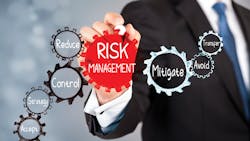ASSP Offers Guidance on Risk Management Techniques
As conditions and technologies change, risk and uncertainty in the workplace continuously evolve. Occupational safety and health professionals can learn about the latest techniques and implementation strategies to combat risk and better protect workers in a new technical report published by the American Society of Safety Professionals (ASSP).
ASSP TR-31010-2020 Risk Management – Techniques for Safety Practitioners is designed to assist safety practitioners and company decision-makers in understanding, assessing and managing risk in all industries so organizations can achieve their business objectives.
The guidance document was developed by the U.S. Technical Advisory Group (TAG) for the ISO/TC 262 risk management technical committee. The report’s techniques expand on the principles and processes of ANSI/ASSP/ISO 31000 Risk Management and other workplace risk standards.
“Risk should be viewed as a continuum that requires constant monitoring and management,” said TAG Chair Bruce Lyon, P.E., CSP, ARM, SMS, CHMM. “The degree of uncertainty can be difficult to measure and communicate within an organization, but it can be reduced through a strong commitment to risk management.”
The technical report provides expert guidance on the selection, modification, combination and application of 50 risk management techniques used to help improve the way risk and uncertainty are managed. It includes basic techniques for industry newcomers and complex methods for seasoned safety professionals.
The safety resource explains the fundamentals of risk assessment and risk treatment and covers prevention-through-design practices that are applicable throughout the life cycle of a system. Safety professionals can apply the techniques to a range of occupational settings, situations and operational stages of a business.
“Risk management techniques should be used by an organization within all steps of the risk management process,” said TAG Vice-Chair Georgi Popov, Ph.D., CSP, ARM, SMS, QEP, CMC, FAIHA. “That systematic course of action includes establishing context, identifying and analyzing risk, evaluating and treating risk, monitoring and reviewing risk, recording and reporting risk, and communicating risk.”
The prevention-through-design component is considered by experienced safety professionals to be the most effective and lasting way to avoid or reduce risk in an operation. It also reduces residual risks that may surface.
As new risks emerge in the workplace, ASSP works to develop educational resources for safety and health professionals, whose mission is to protect workers on the job so they can return home safe and healthy each day. ASSP TR-31010-2020 not only considers current risk management needs but looks toward the future.
About the Author
EHS Today Staff
EHS Today's editorial staff includes:
Dave Blanchard, Editor-in-Chief: During his career Dave has led the editorial management of many of Endeavor Business Media's best-known brands, including IndustryWeek, EHS Today, Material Handling & Logistics, Logistics Today, Supply Chain Technology News, and Business Finance. In addition, he serves as senior content director of the annual Safety Leadership Conference. With over 30 years of B2B media experience, Dave literally wrote the book on supply chain management, Supply Chain Management Best Practices (John Wiley & Sons, 2021), which has been translated into several languages and is currently in its third edition. He is a frequent speaker and moderator at major trade shows and conferences, and has won numerous awards for writing and editing. He is a voting member of the jury of the Logistics Hall of Fame, and is a graduate of Northern Illinois University.
Adrienne Selko, Senior Editor: In addition to her roles with EHS Today and the Safety Leadership Conference, Adrienne is also a senior editor at IndustryWeek and has written about many topics, with her current focus on workforce development strategies. She is also a senior editor at Material Handling & Logistics. Previously she was in corporate communications at a medical manufacturing company as well as a large regional bank. She is the author of Do I Have to Wear Garlic Around My Neck?, which made the Cleveland Plain Dealer's best sellers list.
Nicole Stempak, Managing Editor: Nicole Stempak is managing editor of EHS Today and conference content manager of the Safety Leadership Conference.
